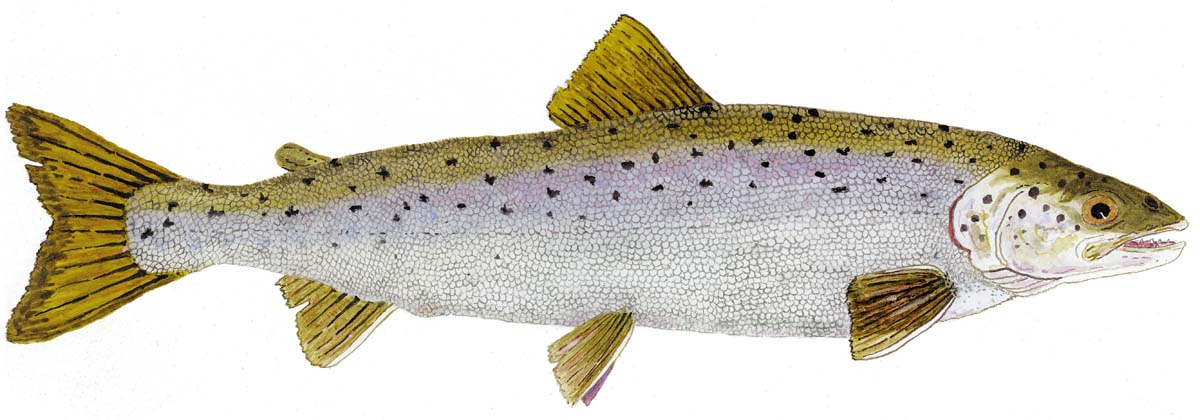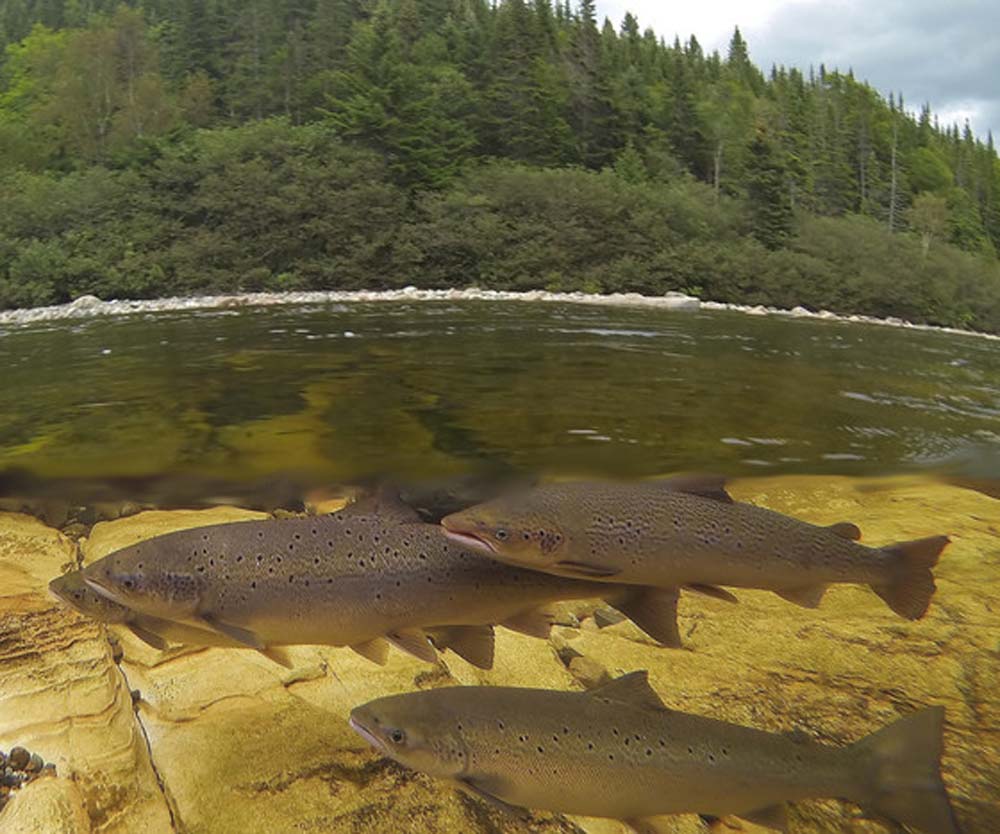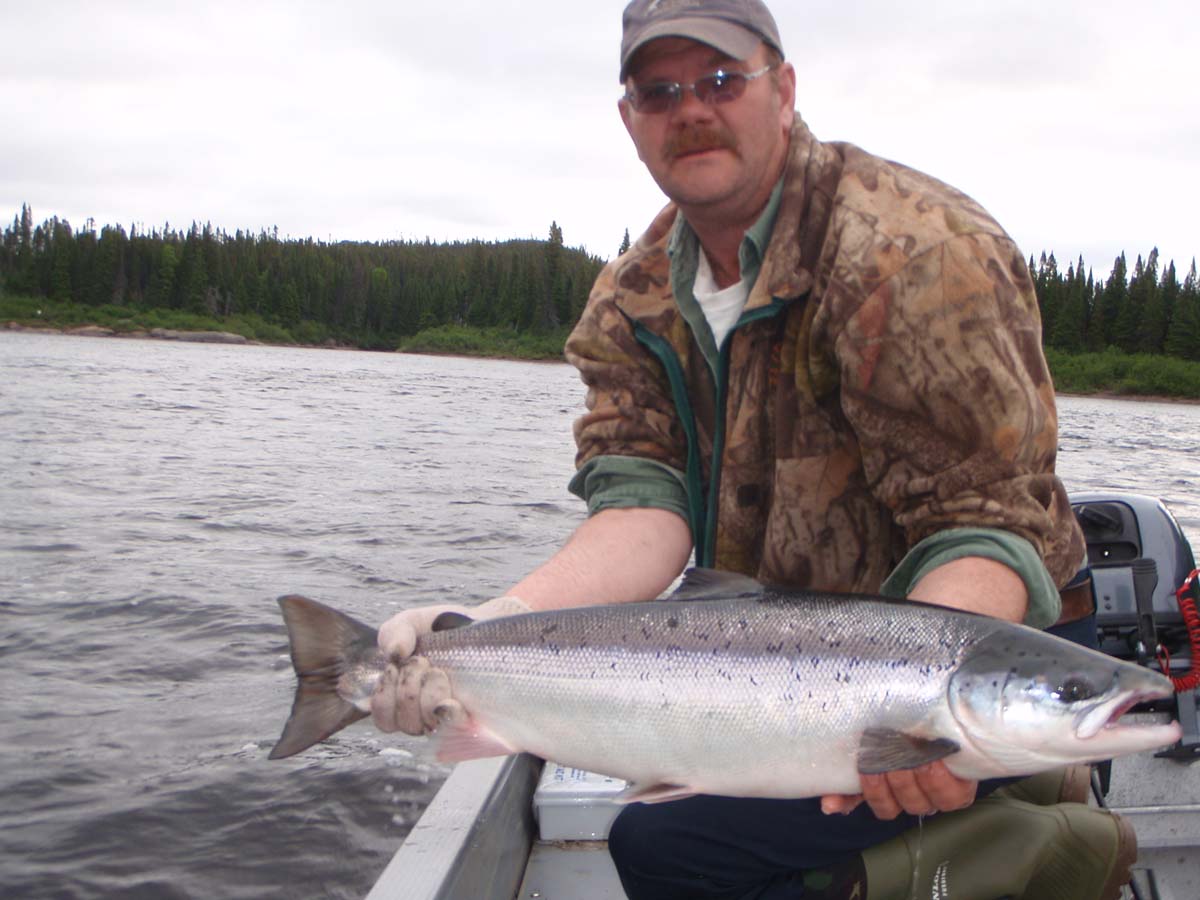 With a long history and an impressive number of ardent supporters, the Atlantic salmon remains one the most popular game fish of the world along with being among the most threatened. Illustration by world renown watercolorist Thom Glace.
With a long history and an impressive number of ardent supporters, the Atlantic salmon remains one the most popular game fish of the world along with being among the most threatened. Illustration by world renown watercolorist Thom Glace.
The Atlantic salmon has no other salmon as a game fish peer because of its speed, fighting ability, and singular need to aerialize when hooked-recorded reaching almost 12-feet on one occasion. Only the mature coho in the Pacific tribe of salmons consisting of chinook, coho, chum, sockeye, and pink, will jump. However, sockeye juveniles will jump. The Atlantic salmon is also is capable of living as long as 13-years, but most Atlantic salmon that survive to reproduce-as many as three times, live 5- to 8-years [1-7 years in freshwater, 1-6 years in the marine environment].
Note: The Masu salmon and amago salmon are the other Pacific salmon- found only in Asia. — Skip Clement
Newfoundland and Labrador Release a Study and Overview on Atlantic Salmon and Hook and Release Best Practices
Overview
The primary goal of the Newfoundland and Labrador Atlantic Salmon Hook and Release Study was to undertake the most comprehensive examination of hook and release for this species, and determine conclusively what the mortality from hook and release is for salmon in this province. A secondary goal was to develop a set of recommendations for the practice and regulation of hook and release angling.
In addition to this overview, the full version of the study has been submitted for publication in a scientific journal. A current draft of the full study is available here.

Atlantic salmon photo E. Peter Steenstra / USFWS. How animals migrate might be one of wildlife’s greatest mysteries. Salmon is no exception. Read More: Christine Peterson is a freelance writer who has spent over a decade writing about science, nature, and the outdoors.
Most Atlantic salmon are anadromous, meaning they undergo their greatest feeding and growth in salt water; however, adults return to spawn in native freshwater streams where the eggs hatch and juveniles grow through several distinct stages.
PRE-HATCH STAGES:
- Green egg – Eggs that are less than 48 hours of being spawned.
- Tender egg – Eggs between the green and eyed stage.
- Eyed egg – Eggs that have the eyes visible.
POST-HATCH STAGES:
- Alevin – Newly hatched young with unabsorbed yolk sac, also called sac fry.
- Fry – Salmon that have absorbed their yolk sacs, emerged from the gravel and are ready to feed.
- Parr – Older juveniles with prominent parr marks.
- Smolt – Young salmon that are ready to go to sea.
- Grilse – Atlantic salmon that have spent one winter in the sea and have returned to the freshwater to spawn.
- Multi-sea-winter salmon – A fish that has spent at least two years at sea before returning to freshwater to spawn. Included are fish that maiden (first time) spawners as well as previous spawners.
- Kelts (black salmon) – salmon which have spawned and are still in freshwater or returning to the sea.

Atlantic salmon photo by Bill Bryden. Newfoundland and Labrador/NOAA.
Results
When biologists compared the survival of salmon that were angled and those released at the counting fence, those that were angled had only slightly lower survival rates. When compared to the control salmon, the angled salmon were three to six per cent more likely to die. The risk of death after hook and release increased substantially as water temperatures increased, especially temperatures above 18 degrees Celsius [64.4F]. A summary of the conditions of the hook and release events can be found in Figures 1 and 2. [Go to complete story for charts and graphs.]
Recommendations
There were a number of factors identified that can influence the risk of death for a hooked and released salmon, however there are a few key best practices that were identified:
- Do not practice intentional hook and release in water temperatures over 18 degrees Celsius;
- Do not remove the salmon from the water.
- Do not touch or handle the salmon unless absolutely necessary (use bare wet hands).
- Other best practices and decision-making points in the hook and release process are also important, but these four recommendations listed above are the most important to consistent successful releases.
Remarkably, the most overlooked cause of death to Salmonids, most notably salmon and large trouts, intended for release back into the wild is dragging them onto the rocks where they will literally beat their brains out.
Death upon a release of that kind will cause death within hours, a mortality rate of over 90%, if my recollection is correct.
— Canadian (BC) university study in the 1990s or early 2000s [not a controlled environment].
Future Research
This first scientific paper was based on data collected during the Newfoundland and Labrador Atlantic Salmon Hook and Release Study, and focused on determining the effect of hook and release on survival of salmon. However, hook and release angling has also been shown to affect behavior (e.g. migration timing) and spawning. Future research planned by the provincial Wildlife Division and DFO scientists will be analyzing the data to determine if hook and release had effects on the movement and spawning of salmon in Western Arm Brook.

Eagle River-Pratt Falls Lodge. A well meaning angler might not have had the advantage of knowing the newest release standards. Photo credit DavidandHeidi.
Hook and Release Best Practices
NOTE:
The following are some best practices for anglers related to hook and release:
1. Be sure you are aware of river conditions and regulatory status. Do not practice intentional hook and release at water temperatures over 18°C.
2. Be prepared to do a release. Have a plan and use the proper equipment including:
a. A knotless rubber net or sling
b. Pliers for removal of the hook
c. Fishing gear suitable to quick play and land salmon
Read complete study here with mortality statistics in a ‘controlled’ environment . . .

